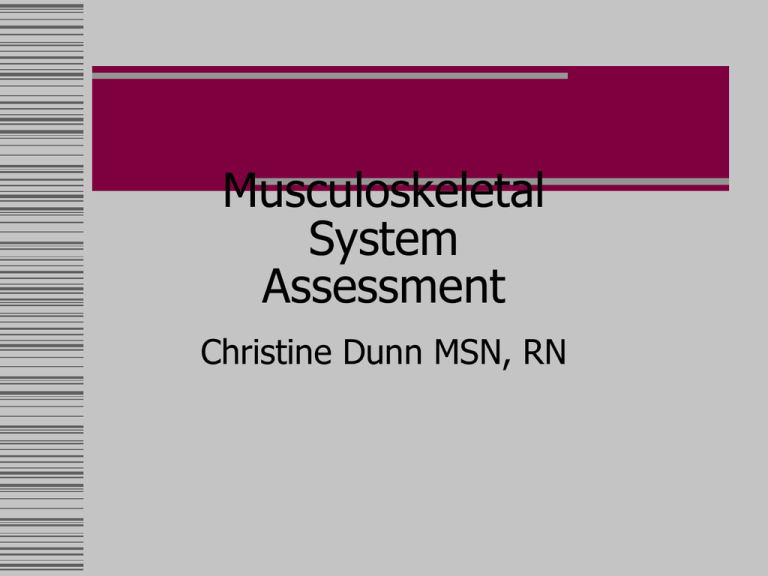Musculoskeletal System Assessment VN 86 2012 Dunn
advertisement

Musculoskeletal System Assessment Christine Dunn MSN, RN Musculoskeletal System What Is It? Consists of muscle, bone, tendons,ligaments cartilage, and joints Primary function: mobility Bone tissue helps regulate blood calcium levels Rapid muscular contraction generates internal heat Produces RBC’s and hemoglobin Skeletal Muscles Move by the actions of muscles on bones Tendons attach skeletal muscles across joints, allowing muscle contraction to move the bones across the joint. Ligaments- bone to bone. Muscles generally work in pairs to produce movement When one muscle flexes (or contracts) the other relaxes, a process known as antagonism. Changes Related to Aging Loss of bone mass- women especially Decreased physical activity Hormonal changes Gait is slower, smaller steps Coordination not always as good- stiff, ROM decreases. Risk for falls increases Effects of medications Immobilization increases functional loss Loss of muscle mass/ ACTIVITY increase needed and exercises; weight train. Effects of Immobility Systemic Metabolic Respiratory Cardiovascular Musculoskeletal Gastrointestinal Urinary Integumentary Psychosocial Musculoskeletal Effects Loss of strength About 12% a week Ultimate: atrophy (shortening of muscles) First muscles affected are lower extremities as tone is maintained by resisting gravity Takes about four weeks to recover Muscle wasting results in imbalance between protein synthesis and breakdown Nitrogen in urine The more breakdown exceed synthesis, the greater the atrophy Final result of disuse is contracture of the muscles – this can be permanent Foot drop Psychosocial Impact of Immobility Threatens person’s values of self-worth achieved through work and hobbies Can lead to depression Limits interactions with friends and family Creates a dependency on others Alters sleep patterns Can result in functional decline in the older adult Assessment: Overview Gait Posture Palpation of Joints Muscles Range of motion Strength Symmetry Activity tolerance Assessment: Subjective Medical history Neuromuscular diseases Arthritis Connective tissue disease Lupus Gout Pain/limited mobility – often the reason to seek care Diagnostic Test Look at your text and discuss. Possible Nursing Diagnoses Risk for Falls Impaired Physical Mobility Impaired Home Maintenance Risk for Disuse Syndrome Sedentary Lifestyle Self-Care Deficit Impaired Transfer Ability Impaired Walking Impaired Wheelchair Mobility NCLEX Questions A nurse is A. a 25 year old conducting health woman who jogs screening for B. a 36 year old man osteoporosis. Which who has asthma of the following C. a 70 year old man who clients is at greatest consumes excess alcohol risk of developing D. a sedentary 65 year old woman who smokes cig. this disorder? NCLEX Questions A nurse witnesses a client sustain a fall and suspects that the right leg may be broken. The nurse takes which priority action? A. Take a set of vital signs B. Call the radiology department C. Reassure the client that everything will be fine D. Immobilize the right leg before moving NCLEX Questions A nurse is obtaining a health history from a client and is assessing for risk factors associated with osteoporosis. Which of the following assessment findings is an unassociated risk factor? A. High-calcium diet B. Postmenopausal age C. Long-term use of corticosteroids D. Family history of osteoporosis









